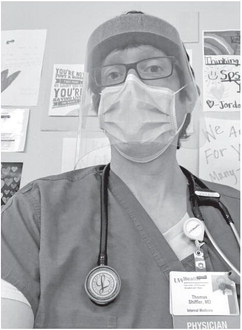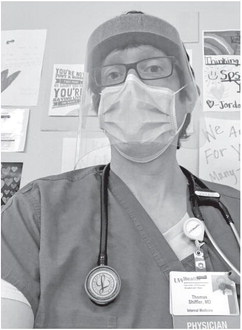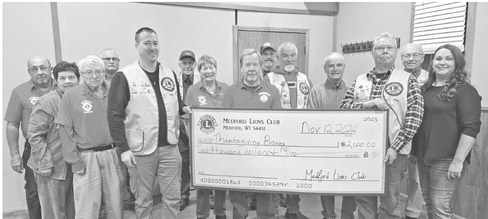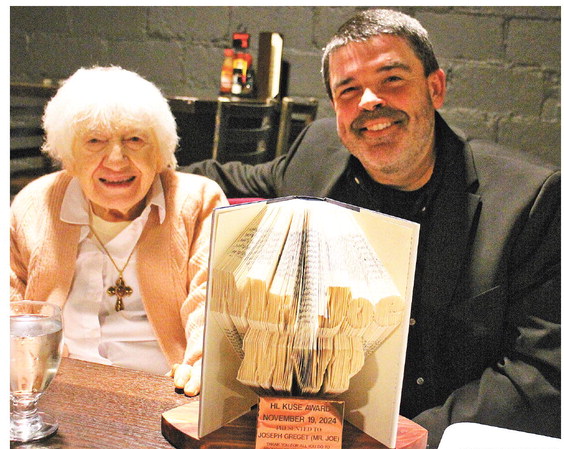Infection fears, isolation are part of the new normal


Dr. Tom Shiffler is seeing the COVID-19 pandemic up close as a primary care physician taking care of patients at UW Health’s Internal Medicine University Station Clinic in Madison.
Shiffler is a 1996 graduate of Medford Area Senior High School and is the son of Ron and Molly Shiffler of Medford. Shiffler received an undergraduate degree from Lawrence University and then went on to gradute with an MD in 2004 from University of Wisconsin Medical School (now UW School of Medicine and Public Health (UWSMPH)). After a year of public health research at Medical College of Wisconsin he started an internal medicine residency at University of New Mexico in Albuquerque which he completed in 2008. Following a chief resident year and a year working as a hospitalist in Albuquerque he and his wife returned to Madison in 2010 where he accepted a position as a clinical assistant professor at UWSMPH. He continues to practice at UW Health in the division of general internal medicine.
“The majority of my time is spent as a primary care physician taking care of patients at UW Health’s Internal Medicine University Station Clinic. I am currently medical director of this clinic which means especially now as we adjust to COVID-19 there are many additional administrative and leadership responsibilities including ensuring good communication between our leaders and employees and implementing changes to ensure the safety of our patients and my coworkers,” he said.
The Star News reached out to Shiffler to share his experiences battling the pandemic in Madison. The views he expresses are his own and not those of UW Health. His answers have been edited for space.
How many suspected/confirmed COVID-19 patients have you worked with?
This is a difficult question to answer because SARSCoV- 2 (the virus that causes the COVID 19 syndrome) was around before we had widespread testing capabilities. Anecdotally, it seemed like I saw more cases in clinic of people having unusually severe symptoms of upper respiratory infections; I suspect in hindsight I was seeing COVID-19, but without testing I cannot be sure. Several of my clinic patients were confirmed positive and I’m glad to say they have recovered well. This month, I’m working in the hospital with one of our resident teams. We are assigned to take care of patients admitted for reasons other than COVID-19. At UW Hospital right now, even patients admitted without symptoms are being tested so we can be quite sure they do not have the virus. We are keeping the COVID-19 patients off resident teams because we want to minimize the quantity of personal protective equipment (PPE) used. On a resident team, it would be normal for three to four members of our team to enter a patient’s room on a daily basis. With the COVID-19 patients cared for by a hospitalist, only one clinician need enter a patient’s room to care for them, so only one person needs to be fully outfitted in PPE.
As of May 4 we know there are 8,236 confirmed cases in Wisconsin and 340 deaths. There are 441 confirmed cases in Dane County and 22 deaths. I am so grateful that there have not been confirmed cases in Taylor County and very much hope that remains true There are many who discount COVID-19 as “just another flu.” Are they right? What in your mind sets this apart?
I wish that were true, but unfortunately, it is not. SARS-CoV2 is a new strain of coronavirus and humans have essentially no immunity and no vaccine for it. The best information we have, while incomplete, shows the virus is deadlier than influenza with an estimated fatality rate of 3 to 4 percent compared to 0.1 percent for seasonal influenza (that means COVID-19 is 30-40 times more deadly than influenza). Without mitigation like public distancing and stay at home orders, the World Health Organization (WHO) tells us each infected person is likely to infect two to three others. This is higher than the rate at which those carrying influenza infect others. But we are not helpless; there are things we can do to help. The WHO and CDC and other public health experts have recommended the large-scale adoption of stay at home orders and public distancing to stop the spread of COVID-19. While these measures are difficult economically, socially, and emotionally, they do work.
Another important thing to know about COVID-19 is that there are ways this syndrome can be deadly aside from the respiratory disease. For example, it causes some patients to develop strokes and blood clots in the lungs. We don’t know exactly why this happens. Finally, there are patients who have no risk factors who are dying quickly from the disease. We do not yet understand how to predict or prevent these tragic deaths. This is a very different virus than influenza, as evidenced by the devastation seen around the world.
How has COVID-19 changed how you interact and treat your patients?
It is a totally new world. We have very knowledgeable experts at UW Health considering each detail of patient care and our division is working closely with them to make sure our health care workers and patients are safe. I now see patients in clinic only about one day per week and it is only for issues that truly need a clinic appointment. Many visits are occurring over the phone and, soon, mostly through video. When I do see patients in person, I wear scrubs instead of a white coat; I also wear a face shield with a surgical mask, if not a more protective N95 mask, underneath. I take the same precautions when I see hospitalized patients and if there is any concern a patient might have COVID-19, I wear full PPE which includes gown and gloves. The effect is much less personal interaction with patients. I try to spend the time I need in the visit and exam to make shared decisions about care but, undoubtedly, in-person exams are briefer and more focused.
What kind of impact have you seen this have on patients and their families?
I am so grateful that my patients with COVID-19 have not died, though their symptoms (including severe chills, fevers, muscle aches, cough and shortness of breath) sound miserable. One thing I would like people to consider is the mental health toll this is taking on patients and those who care for them, including their families and health care workers. When talking to my patients who have COVID-19, the concern in their voice is obvious. We ask them to self-isolate in their home, meaning, if possible, they live in one room by themselves and only come out of their room to use the bathroom or get food (while wearing a mask). They are all afraid they may infect their loved ones. Many of my patients are suffering from worsened anxiety related to this pandemic even if they have not had COVID-19. The isolation is especially difficult on families. A patient of mine recently endured the death of a spouse from a non-COVID-19 cause. As the dying spouse was in a facility, family members were not able to be present until the very end of life. As you can imagine, this was incredibly difficult for the family. This is also a concern for my patients in the hospital as they would normally be allowed to have visitors, but now are much more isolated and feel more alone. My experience is that although my patients and their families are universally understanding of the precautions and want to do their part in the pandemic, the isolation is challenging.
In times of crisis like this you really find out a lot about people and communities and I want to make note of the impact that patients and their families have on us as health care workers. One thing that continues to strike me is the outpouring of gratitude from patients and their families. At the end of just about every phone call with a patient, they will ask how I’m doing and thank all of us health care workers for what we are doing in a way that is more genuine and sincere and heartfelt than ever before. Even though our community members are worried about themselves and their loved ones, they take the time to thank health care teams. We have been fighting this pandemic for close to two months, and this kindness still leaves me choked up.
What has been the toughest case you have worked on?
I feel very fortunate that I have not had the experience yet of my colleagues in places where the virus has been out of control. My patients who have been confirmed positive have recovered. However, talking to these patients over the phone there is a sense of helplessness as there is not a lot to help them feel better quickly.
One patient that stands out represented a case study of how a pandemic occurs. This patient had been at a conference with many international participants and met with a number of fellow attendees over several days. This person traveled through two large international airports and remained asymptomatic until several days after returning. I remember reviewing all this history and just sitting back in my chair and thinking, “This is how a pandemic happens.”
A significant number of those who tested positive are in healthcare. Are you afraid of getting sick? Are you afraid of bringing it back to your family?
My worst fear is bringing the SARVS-CoV-2 virus back to my wife and children. We are strictly isolating ourselves and our children have not seen other family members or friends in person for close to two months now. This has been difficult, but at least I know I will not pass it to anyone outside our immediate family. Fortunately, the COVID-19 syndrome is mild in children and rarely deadly. My wife and I are privileged with good health so realistically we would expect to survive, but of course COVID-19 is unpredictable. This virus has killed health care workers and I’m preparing myself mentally that at some point one or more of my friends, family, or colleagues in health care will die from COVID-19.
One thing that does help me manage any fear or anxiety is that I am taking action to help my community and the people I care about through this pandemic. Just working with my colleagues and co-workers is inspiring. We’ve made changes in weeks that would normally have taken years. I almost never hear “no,” but instead “how” and “we’ve got this.” There is a collective resilience and compassion and protective nature that is energizing and really driving me to keep going. Especially hearing firsthand accounts from my friends working in places that are overwhelmed just motivates me all the more to do anything to keep that from happening to my community.
Do you take extra precautions or have you changed anything in your daily routine to keep from getting sick or spreading it to others?
I have the ultimate respect for this virus and one thing that does give me peace of mind is that I can do some things to reduce my chance of bringing the virus to my family or getting it myself. The room where I meet with my resident team is adjacent to the COVID-19 unit so I am especially careful when I am working in UW Hospital. My routine includes: -showering before work and putting on clean scrubs -self monitoring by checking my temperature (cannot work if 100.0 or higher) -wearing a mask going to clinic or the hospital and switch to at least a surgical mask when at work -going through employee screening with temperature check and am asked about new symptoms (I also cannot work if I have new symptoms until testing negative and being cleared by employee health) -surgical/N95 mask and face shield for all interactions with patients and at least a surgical mask at all times unless eating or drinking -end of day clean off my shield and put surgical mask and face shield in a paper bag to be used the next day -keep anything that was out in the hospital in one pocket of my fleece (pager, ID badge, phone, etc.) and things like my wallet and keys in the other -change out of scrubs into clean clothes and tie off the scrubs I wore for patient care in a plastic bag -walk home wearing my mask -enter through our side door and leave everything hanging on our basement landing which is a low traffic area. The clothes I wore will remain in a plastic bag until
washed on a sanitary cycle after 72 hours or more -shower and change into clean clothes -say hello to my family!
I was struck by how my family has also become accustomed to this routine. As I returned home this week they were heading out for a walk. The children knew they couldn’t come hug me and everyone kept their distance with the exception of our chocolate lab puppy who was charging and pulling as hard as he could to come to me. The stark contrast really drove home how much our behaviors had changed to keep each other safe.
There are those, including some in the medical profession, who say we should reopen everything. What would you say to them and why SARS-CoV-2 is a virus. It spreads, infects and kills with no political agenda or other motive, but some have politicized options for responding to this pandemic and I worry that decisions will be made for political reasons rather than based on data about the virus. I certainly empathize with business owners calling for reopening, not for political reasons, but in the hope that their business can survive this pandemic. Understandably they are legitimately concerned about the financial impact not just on themselves but for their employees. I think reopening our communities needs to be done thoughtfully, deliberately, informed by the data, and with input from local public health officials. The situation is challenging and people are truly suffering from many different aspects of the COVID-19 pandemic, not just the illness itself. It feels good to think that there could be a shortcut or miracle cure that would allow us to resume our regular lives without endangering our friends and neighbors, but there simply isn’t. The safest way forward is to rely on good data and sound expert advice. When we do reopen our communities, we also need to pay close attention for rising cases of COVID-19 and be prepared that mitigation efforts may need to be put back in place. We can learn from past pandemics (notably the influenza pandemic of 1918) that a second wave can be just as deadly, if not more, than the first. Reopening too soon or too fast is dangerous as it can lead to a second wave with both health and financial consequences. SARS-CoV-2 is a virus that you do not want in your community. Recent data show infection and death rates in rural U.S. are now exceeding those in the metro U.S. So even though Taylor County has been spared, there is still reason for caution and vigilance as we reopen.
You may have heard people using the term “flatten the curve.” That means taking steps to slow the spread of disease to ensure that hospitals, clinics, and health care systems won’t be overwhelmed with cases all at once. If health care systems are overwhelmed, there won’t be enough providers, safety equipment, medicine, ventilators, or hospital beds, and more people will die. In Wisconsin, with all the efforts and sacrifices of our citizens, we have flattened the curve in our state. This is literally saving lives, but it can trick us into believing that the virus is not that dangerous. It is important to remember that if we “do it right”, it may look like we were overreacting, when really, our efforts simply worked well.
How long do you think this will go on? Do you have hope that things will return to “normal” anytime soon?
Wouldn’t that be wonderful to know? People much more knowledgeable than me have made estimations of months to years but the truth is no one can really be sure. An effective vaccine is something that will be a “game changer,” but we all realize that is not coming soon enough. I would suggest that many of the changes brought about by this pandemic will be part of a “new normal” and we all need to prepare and adjust to this “new normal.” In my professional world routine video visits with patients were something we were moving toward gradually, now that is part of our present and is not something that will go away. Some of the public distancing practices and precautions in public spaces are likely to stay. Unfortunately, with each answer comes many more questions.
Right now, I think it is crucial that our “new normal” is shaped by data about this pandemic and understanding the impact of this virus. Personally, I am very grateful to everyone who has been public distancing and doing what they can to prevent the spread of this virus. We won’t be able to stop or eradicate it, but my hope is that it will move through communities like a controlled burn rather than a wildfi re. I am grateful I am not in the hospital 100 hours a week taking care of COVID-19 patients. I am grateful that so far, my patients, family and friends have been kept safe. Thank you for everything you are doing to take care of each other and your community.



